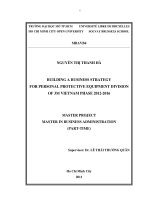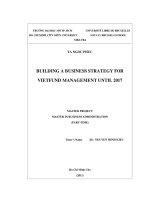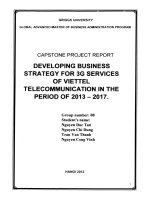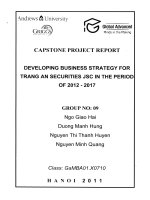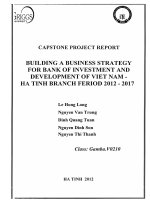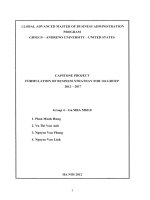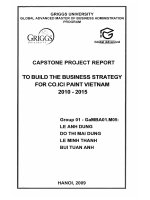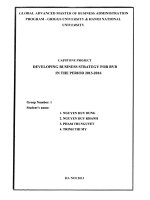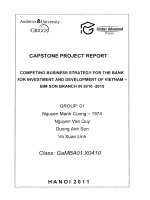Crafting a business strategy for ha tay pharmaceutical jointstock company for period 2011 - 2015
Bạn đang xem bản rút gọn của tài liệu. Xem và tải ngay bản đầy đủ của tài liệu tại đây (5.51 MB, 95 trang )
CRAFTING A BUSINESS STRATEGY FOR
HA TAY PHARMACEUTICAL JOINT STOCK
COMPANY FOR PERIOD 2011 - 2015
Nguyen Thi Tuyen
Ngo Van Chinh
Le Anh Khanh
Le Thanh Khuyen
Class: GaMBA.X0409
H A N O I 2 0 1 1
CAPSTONE PROJECT REPORT
HA NOI 2011
GRIGGS UNIVERSITY
GLOBAL ADVANCED MASTER OF BUSINESS ADMINISTRATION
PROGRAM
CAPSTONE PROJECT REPORT
Nguyen Thi Tuyen
Ngo Van Chinh
Le Anh Khanh
Le Thanh Khuyen
Group Number: 09
Student’s name:
CRAFTING A BUSINESS STRATEGY FOR
HA TAY PHARMACEUTICAL JOINT STOCK
COMPANY FOR PERIOD 2011 - 2015
LIST OF FIGURE
Chapter 1
Figure 1.1: Michael Porter PEST Analysis Model 12
Figure 1.2: Michael Porter’s Fiver Competitive Forces 15
Figure 1.3: M. Porter Value Chain Model 21
Chapter 2
Figure 2.1: Hataphar’s Certificate of Good Manufacturing Practices 34
Figure 2.2: Some of the Awards achieved by Hataphar 35
Figure 2.3: Organizational structure of Hataphar 35
Figure 2.4: Growth Rate of GDP and Sales of the Local Pharmaceutical
Industry 46
Figure 2.5: Scope of Local Market of Viet Nam Pharmaceutical
Industry 47
Figure 2.6: Pharmaceutical Consumption Market Share 48
Figure 2.7: Annual Per Capita Expenditure on Medicine USD/head/year)
49
Figure 2.8: 2010 CPM and MPI Growth Rate 50
Figure 2.9: Hataphar’s Labour Structure 63
Figure 2.10: Value Chain 65
Chapter 3
Figure 3.1: SPACE Matrix 79
Figure 3.2: The IE matrix of Hataphar 82
2
GaMBA.X0409 – Group Number: 09
LIST OF TABLE
Chapter 1
Table 1.1: Simplified SWOT Analysis 28
Table 1.2: QSPM Matrix 31
Chapter 2
Table 2.1: Competitiveness Matrix in the pharmaceutical business of
Hataphar 56
Table 2.2: The matrix for the assessment of external factors 58
Table 2.3: Hataphar’s financial state 59
Table 2.4: Hataphar’s Loan Outstanding 60
Table 2.5: Hataphar’s Key Raw Materials and Countries of Origin
70
Table 2.6: Pharmaceutical Product Line and Financial Indicators 73
Table 2.7: Internal Forces Evaluation Matrix of Hataphar’s
pharmaceutical business 75
Chapter 2
Table 3.1: The SPACE matrix of Hataphar 78
Table 3.2: The SWOT matrix of Hataphar 80
Table 3.3: QSPM matrix for Hataphar 83
Table 3.4: Plans for Capital Sources and Funds for Years 91
3
GaMBA.X0409 – Group Number: 09
TABLE OF CONTENTS
ACKNOWLEDGEMENTS 6
CERTIFICATION 7
EXECUTIVE SUMMARY 8
1. RATIONALE 8
2. SCOPE AND OBJECTIVES 8
2.1. Scope of Study 8
2.2. Objectives 9
3. METHODOLOGY AND STRUCTURE 9
3.1. Data Collection 9
3.2. Comparative Study and Synthesis 9
3.3. Statistical Method via Tables and Charts 9
3.4. SWOT Analysis 9
3.5. Structure of the Thesis 10
CHAPTER I: THEORETICAL PRINCIPLES: BUSINESS STRATEGIES –
AN OVERVIEW 11
1.1. BASIC CONCEPTS 11
1.1.1. Strategy 11
1.1.2. Strategic Management 11
1.1.3. The Role of Strategic Management 12
1.2. BUSINESS ENVIRONMENT ANALYSIS 12
1.2.1. Macro Environment Analysis 12
1.2.1.1. Political Factors 13
1.2.1.2. Economic Factors 13
1.2.1.3. Socio-cultural Factors 13
1.2.1.4. Technological Factors 13
1.2.1.5. Global Factors 14
1.2.2. Micro Environment Analysis (Competitive Environment) 14
1.2.2.1. Bargaining Power of the Buyers 16
1.2.2.2. Bargaining Power of the Sellers 16
1.2.2.3. Rivalry among the Existing Competitors 17
1.2.2.4. Threat of New Entrants 17
1.2.2.5. Threat of Substitute Products 18
1.2.3. External Factor Evaluation Matrix (EFE) 18
4
GaMBA.X0409 – Group Number: 09
1.3. CORPORATE INTERNAL ENVIRONMENT ANALYSIS 19
1.3.1. Analysis of Functional Resources 19
1.3.2. Value Chain Analysis 21
1.3.2.1. Key Operations 22
1.3.2.2. Supporting Operations 23
1.3.2.3. Crosswise Objectives – Functions 24
1.3.2.4. Outsourcing 24
1.3.3. Internal Forces Evaluation Matrix 25
1.4. BUILDING AND CRAFTING OPTIMAL BUSINESS STRATEGY 25
1.4.1. SPACE Matrix 26
1.4.2. SWOT Matrix and Crafting an Optimal Strategy 27
1.4.2.1. SWOT Analysis 27
1.4.2.2. SWOT Analysis Matrix 28
1.4.3. IE Matrix 29
1.4.4. QSPM Matrix 30
CHAPTER II: CURRENT STATE OF BUSINESS PERFORMANCE OF HA
TAY PHARMACEUTICAL JSC 33
2.1. INTRODUCTION 33
2.1.1. Background 33
2.1.2. Development History 34
2.1.3. Organizational Structure 35
2.1.4. Corporate Vision, Mission and Core Values: 37
2.1.4.1. Vision 37
2.1.4.2. Mission 37
2.1.4.3. Development Viewpoints 37
2.1.4.4. Core Values 37
2.2. BUSINESS ENVIRONMENT ANALYSIS OF THE COMPANY 38
2.2.1. Macro Environment Analysis 38
2.2.2. Micro Environment (Competive Environment) Analysis 46
2.2.2.1. Current State of the Pharmaceutical Industry of Viet Nam 46
2.2.2.2. Michael Porter’s Five Competitive Forces Analysis 52
2.2.2.3. The Matrix for the assessment of external factors 57
2.3. HATAPHAR INTERNAL BUSINESS ENVIRONMENT ASSESSMENT 59
2.3.1. Resources assessment 59
2.3.1.1. Tangible resources 59
2.3.1.2. Intangible resources 62
2.3.2. Value Chain Analysis 64
5
GaMBA.X0409 – Group Number: 09
2.3.2.1. Key Operations 65
2.3.2.2. Supporting operations 69
2.3.3. Internal Forces Evaluation Matrix 75
CHAPTER III CRAFTING BUSINESS STRATEGIES FOR HA TAY
PHARMACEUTICAL JSC FOR PERIOD 2011 – 2015 76
3.1. CRAFTING BUSINESS STRATEGIES FOR PHARMACEUTICAL PRODUCTS LINE AT
HATAPHAR TOWARDS 2015 76
3.1.1. Vision, Mission and Objectives 76
3.1.1.1 Vision 76
3.1.1.2. Mission 76
3.1.1.3. Objectives 76
3.1.2.Objective-Setting Basis 77
3.2. STRATEGY DEVELOPMENT AT BUSINESS UNIT LEVEL FOR THE
PHARMACEUTICAL PRODUCTS LINE 77
3.2.1. Specific Business Strategies for the Pharmaceutical products line of Ha
Tay Pharmaceutical Joint Stock Company. 77
3.2.1.1. The SPACE Matrix 77
3.2.1.2. The SWOT matrix 79
3.2.1.3. The IE matrix of Hataphar 81
3.2.1.4. The QSPM matrix for focused growth strategies for pharmaceutica
products line 82
3.2.2. Assessment of the choice of strategies 84
3.2.2.1. Local Market Penetration 84
3.2.2.2. Product Development Strategy 85
3.2.2.3. Vertical Backward Integration 85
3.2.3. Specific Policies for the Enhancement of the Company’s Essence Values
86
3.2.3.1. Human Resources 86
3.2.3.2. With Regard to R&D 88
3.2.3.3. Maketing 88
3.2.3.4. Management (quality management, financial management …) 90
3.2.3.5. Finance 91
CONCLUSION 92
BIBLIOGRAPHY 93
6
GaMBA.X0409 – Group Number: 09
ACKNOWLEDGEMENTS
First of all, we own deep gratitude to the Griggs International MBA Training
Program for its successful organization of the MBA course for us, the students of
the class GaMba01.X0409. The different modules delivered in the course have
provided us with useful knowledge and practical experience in all the important
areas of business administration.
Next, we are sincerely grateful to Mr. Tony Sanichara and Mr. Vũ Thành Hưng
for their interesting lectures, and responsible and warm guidance to us in doing this
Master Thesis. In the module “Strategic Management” delivered by these two
professors, we have been introduced to a great variety of tools for the analysis and
development of corporate business strategies and the latest international business
administration trends. Such tools and knowledge are highly relevant and useful to
our current work.
Our thesis would not be possible without the invaluable support of Ha Tay
Pharmaceutical Joint Stock Company, who have provided us with thorough
information of their business operations for our study and arranged our interviews
with their key personnel in the leadership.
Last but not least, we are thankful to our classmates for their continued support and
cooperation. They have helped us coordinate the comments on our thesis detailed
outline, and continuously encouraged us throughout the process of our thesis
writing.
7
GaMBA.X0409 – Group Number: 09
CERTIFICATION
It is our certification that the Master Thesis of International Business
Administration titled “Crafting business strategies for Ha Tay Pharmaceutical
Joint Stock Company in period 2011 – 2015” is the original research work
produced by Group 9.
All the information and data used in the thesis is correct to the best of our knowldge.
8
GaMBA.X0409 – Group Number: 09
EXECUTIVE SUMMARY
1. RATIONALE
Viet Nam national economy is experiencing gradual and deep integration with the
regional and global economies. Such integration is associated, on the one hand, with
expanding business environment, but also with more severe competition, on the
other hand. The regional and global economic integration creates numerous
business opportunities, while posing potential threats to the business growth of local
firms. During the contemporary period, the domestic pharmaceutical industry is one
of the State priorities for investment and development, which is a good opportunity
to the domestic pharmaceutical firms. In the market conditions full of changes, and
regardless of the coincidental factors, the key to business success of a firm is
selecting the right direction and crafting suitable and timely business strategies.
Ha Tay Pharmaceutical Joint Stock Company (HATAPHAR), was originally
established as a State-owned enterprise and went privatized in 2000. During the
conversion process, the company has continuously applied strategic business
administration approaches in its actual business operations and has gained fruitful
results.
Being aware of the key role of business strategy development in the business
operations of a firm, we have selected the thesis title “Crafting a business strategy
for Ha Tay Pharmaceutical Joint Stock Company for period 2011-2015” to
apply the theories and principles of business administration obtained through our
master training course to the actual business practice.
2. SCOPE AND OBJECTIVES
2.1. Scope of Study
The scope of the study is to review the business performance of Hataphar over the
past time and propose business development strategies for the firm in period 2011-
2015.
9
GaMBA.X0409 – Group Number: 09
2.2. Objectives
The study is aimed to verify some key theories and methodology of building and
implementing business strategies in Hataphar based on the analysis of its business
performance and environment over the past period.
3. METHODOLOGY AND STRUCTURE
3.1. Data Collection
Primary data collection: is performed via the study and observations of the
company’s actual performance, and interviews with individuals (mostly employees
of the company under study), and email exchanges.
Secondary data collection: secondary data is collected from reports and documents
provided by the company where the group conduct their internship. Such data is
also retrieved from statistical yearbooks, the information published in newspapers,
television, the Internet and other completed studies or research work.
3.2. Comparative Study and Synthesis
Comparative study means comparing the achieved indicators of business
performance with the baseline indicators. The market indicators, the average
indicators can be compared via other methods. The conditions for comparison is the
matching of the space, time, economic issue, measurement unit, calculation method,
scope and business conditions.
3.3. Statistical Method via Tables and Charts
This method discovers the tendency of common features of the factors under the
analysis.
3.4. SWOT Analysis
SWOT analysis is used to identify the internal strengths and weaknesses of the a
firm, and the opportunities and threats from the external environment. This is the
core method in strategy development.
10
GaMBA.X0409 – Group Number: 09
3.5. Structure of the Thesis
The thesis paper is structured into three Chapters:
Chapter 1: Theoretical Principles – Business Strategies, an Overview
Chapter 2: Current state of business operations of Ha Tay Pharmaceutical
Joint Stock Company
Chapter 3: Crafting business strategies for Ha Tay Pharmaceutical Joint
Stock Company in period 2011 – 2015
11
GaMBA.X0409 – Group Number: 09
CHAPTER I
THEORETICAL PRINCIPLES: BUSINESS STRATEGIES –
AN OVERVIEW
1.1. BASIC CONCEPTS
1.1.1. Strategy
According to Micheal Porter, “Strategy is research for a suitable competitve position
in an industry, a key scope of operations where competition is taking place.”
William F.Gluek defined “Strategy as a consistent, comprehensive and combined
plan designed to ensure that the key corporate objectives be fully achieved”.
A corporate business strategy is a choice and combination of different measures
(corporate strengths), time, opportunities and space (business areas) that matches
the corporate environment analysis and available resources to achieve the oriented
business objectives of a firm.
Strategies always go forward to gain competitive edges in the business. It is
necessary that strategies be planned and executed amist the growth of business
opportunities and awareness of the competitive advantages of the business for
optimal business efficiency.
1.1.2. Strategic Management
Strategic management is a continuous process that starts from the study of the
existing environment and forecasts, then sets strategic objectives for the
organization, executes and monitors the implementation of the taken decisions to
achieve the set objectives in the existing and future conditions.
Strategic management is considered the art and science of making, executing and
evaluating the decisions related to the different fuctions that allow the business to
achieve the set objectives in a certain period of time.
Strategic management focuses on merging the management of marketing, finances,
production, R&D and the information systems of business areas to achieve success.
In the Strategic management process, three bacis fuctions of management must be
12
GaMBA.X0409 – Group Number: 09
performed through the three stages of strategic management: strategic planning,
implementation of strategies, and monitoring and evaluation of strategies.
1.1.3. The Role of Strategic Management
Strategic management is like an orientation that steers organizations to overcome
obstacles and hurdles in the business arena and head for future by their own
endeavours and competence. Strategic management is a science of management
because if the governance procedures are well designed, they will be sound
foundation for organizations to move forward in their business performances.
Strategic management makes an organization more active in its future planning and
allows it to become a pioneer and influence others in its areas of operations. The
organization, therefore, can make full use of its competence to control its operations
over the unexpected developments.
Strategic management provides individuals with important insight. Both the Board
and the employees are fully aware of and committed to achieving the corporate
objectives. Once, each person in the firm is well-aware of what their organization is
doing and why, they will have the feeling that they are part of the organization, and
will be committed to supporting all the corporate activities.
1.2. BUSINESS ENVIRONMENT ANALYSIS
1.2.1. Macro Environment Analysis
Figure 1.1: Michael Porter PEST Analysis Model
(Source: )
P
E
S
T
olitical Factors (thể chế - luật pháp)
conomic Factors ( Kinh tế)
ociocultural Factors (Văn hóa – Xã hội)
echnological Factors (Công nghệ)
13
GaMBA.X0409 – Group Number: 09
These four factors have direct impact on the different industries. They are external
to the firm and industry and their effects on the industry are considered objective.
The firms, based on the identified effects, will initiate appropriate policies and
business activities.
1.2.1.1. Political Factors
These factors influence all the businesses in a territory and can be a threat to the
existence and growth of any industry. When doing business in an administrative area,
the firms are obliged to comply with the political factors and regime of the area.
1.2.1.2. Economic Factors
It is essential that firms pay good attention to the economic factors in both short and
long terms and the government interventions to the economy. It is common practice
that the firms make reference of the economic factors to decide their investments in
the suitable industries and business areas.
1.2.1.3. Socio-cultural Factors
Each country and territory have their own cultural values and typical social factors,
which outline the features of the customers in their respective areas.
Cultural values shape a society and nurture its existence and growth. Therefore, the
cultural factors, especially the spiritual cultural values are massively and strictly
protected. However, cultural exchanges with other countries are unavoidable. These
exchanges will influence and change the consumers’ sentiment, lifestyle and create
potential for growth to the industries.
Apart from cultural factors, social features are of central interest of firms in their
market research. The social factors will categorize a society into different groups of
customers, bearing their own features, sentiment and levels of income.
1.2.1.4. Technological Factors
The whole globe is currently dipped in a technological revolution, in which a great
14
GaMBA.X0409 – Group Number: 09
many new technologies have been invented and incorporated into the different
products and services. If thirty years ago, computers were solely used for
calculation, they are now sufficiently functional to replace a working person.
1.2.1.5. Global Factors
It is undeniable that globalization has become a tendency, that do not create
opportunities for firms and nations in developing their production and business
activities.
Globalization creates pressure of competition from competitors all around the world.
In the course of the global integration, firms are forced to adapt themselves to the
competitive advantages and labor distribution in their respective regions and the
whole world.
It is also important that in the global integration, trade barriers will be gradually
removed and firms will have opportunities to do business with those partners in
long-distanced geographical areas. There customer base is composed of not only
local customers in their home countries, but exotic ones throughout the world.
1.2.2. Micro Environment Analysis (Competitive Environment)
An industry is composed of a group of firms that provide those closely substituable
products or services. This means these products or services can basically meet the
customers’ demands in a similar manner.
Industry and competitive analysis is a set of concepts and techniques to clarify the
key issues:
The outstanding economic features of the industry;
The competitive forces opearting in the industry, the nature and power of
each of these forces;
The motives for changes in the industry and their impacts;
Who to create the next move in the industry;
15
GaMBA.X0409 – Group Number: 09
The key factors for success or failure in competition;
The attractiveness of the inustry from the perspective of above-average
profitability;
The environment of an industry is influenced by the following issues:
According to M. Porter, five competive forces in an industry are: (1) Threat of new
entrants; (2) Rivalry among existing competitors; (3) Bargaining power of the
buyers; (4) Bargaining power of the sellers; and (5) Threat of substitute products.
Figure 1.2: Michael Porter’s Fiver Competitive Forces
(Sources:2009, Le The Gioi,et al., “Strategic Managemen”; M. Porter’s Five
Competitive Forces Model, p.106)
It has been indicated by M. Porter that the stronger these forces, the smaller the
possiblity for the existing firms to increase their prices and profitability. The
assignment set for business managers is to identify the opportunities and threats
created by the changes of these five forces, on which basis they can develop
appropriate strategies to turn the power of one or many of these competive forces to
their advantages.
Bargaining
Power of
Suppliers
Threat of New
Entrants
Bargaining
Power of
Buyers
Threat of Substitute
Products
Rivalry among
Existing Competitors
16
GaMBA.X0409 – Group Number: 09
1.2.2.1. Bargaining Power of the Buyers
The buyers are considered a competitive threat when they bargain for low or
average price for better quality services, which leads to increased operational costs
of a firm. On the contrary, if the buyers’ bargaining power is weak, it is an
opportunity for the firm to increase their prices for higher profits.
The pressure from the buyers is determined by the following elements:
- Whether the buyers’are concentrated;
- Whether the firm is a key supplier;
- The buyers’ degree of loyalty;
- The buyers’ power to seek substitute products;
- Converting costs;
- Vertical integration possibility;
1.2.2.2. Bargaining Power of the Sellers
The sellers are considered a threat to a firm if they can increase the prices of their
supplies to the firm or reduce quality of the supplied products, change terms of
payments, terms of delivery that affect the costs, the product quality and thus the
firm’s profitability. Firms usually establish good partnership with the suppliers of
commodities and other inputs such as labor, materials, equipment and finances. The
elements that increase the pressure from suppliers are similar to those from the
buyers, including:
- Limited number of suppliers, which limits the firms’ choices;
- Limited number of substitutes for the products on request;
- Whether the firm is a key customer of the supplier;
- Whether the supplier is concentrated or not; if yes, the pressure from
them will be higher and the firm will be in disadvantaged position;
17
GaMBA.X0409 – Group Number: 09
1.2.2.3. Rivalry among the Existing Competitors
Rivalry among the existing competitors in an industry becomes fierce when a firm
is challenged by the actions of the other firms or when a certain firm in the industry
is aware of the opportunities to improve its market position.
The competition in an industry will become fierce when:
- There are many competitors or the competitors have equal power;
- The industry is slowing down or declining;
- The fixed or inventory costs are high;
- There are few opportunities for differentiation or low converting costs;
- The strategic benefits are high;
- There are many obstalces for the firm’s exit from the industry;
1.2.2.4. Threat of New Entrants
New entrants are those firms which are not operating in the industry but potential to
enter the business operations in the industry. The new entrants to an industry can be
a factor that makes profits of the existing firms in the indistry shrink. Yet how the
new entrants will affect the existing firms’ operations depends on their
competitiveness (business scale, technology ). The entry of these new competitors
will also change the competition scenario of an industry. Whatever the competition
scenario these new entrants create, their entry into the industry makes the
competition more intense. For these reasons, the existing firms in an industry
always seek every measure to limit the new entrants into their business areas.
According to M. Porter, however, external firms that want to enter an industry may
face a number of obstalces, namely:
- Customers’ favour of the existing products which are supported by the
advertising, labeling, products’ quality and after-sales services;
- The problem in reducing costs at the early stage of entry into a new industry;
- The efficiency of the economies of scale;
18
GaMBA.X0409 – Group Number: 09
1.2.2.5. Threat of Substitute Products
Substitute products are those products produced by the existing competitors, which
is regular pressure and a direct threat to a firm. Substitute products are those
products produced by the existing firms in an industry or the external firms but all
satisfy the demands of the customers.
Hence, the existence of substitute products creates tremendously competititve
pressure and limits the level of price that a firm can set for its products, and
consequently limits its profitability. On the contrary, if a firm’s products have few
substitutes, the firm can increase its prices more easily and earn higher profits.
Substitute products can also be found within a firm.
1.2.3. External Factor Evaluation Matrix (EFE)
EFE matrix is one of the strategic management tools used to evaluate the
contemporary business conditions to identify opportunities and threats of the
external environment to a firm. The factors evaluated in the EFE matrix include
political, economic, social, legal and other external factors. The steps to
formulate an EFE matrix are:
- To list out the external factors that may influence the operation of the firm.
These factors are categorized into Opportunities and Threats.
- To classify the factors by their degree of importance that reflect the degree
of their influence on the business areas that the firm is dealing in. The
factors are rated from 0 to 1 point. 0 point means that factor is not
important to the firm, and 1 point means the factor is of significant
importance to the firm. The total weighted point must be 1.
- To determine the weighted point for each factor in the range of 1 to 4. The
weighted point reflects the degree of the firm’s responsiveness to each
factor. 1 means poor responsiveness, 2 means below average, 3 – above
average and 4 – good responsiveness.
19
GaMBA.X0409 – Group Number: 09
- To multiply the degree of importance with the classified weighted point of
each factor to determin the rating of that factor.
- To add up all the sub-ratings of all the factors to determin the overall
rating for the firm.
Evaluation:
The highest overall rating in the EFE matrix is 4.0, and the lowest rating is 1.0,
while the average rating is 2.5
- If the overall rating is 4.0, the firm has well responded to the opportunities
and threats from the external environment. In other words, the firm has
made full use of the opportunities offered from the external environment
and mitigated adverse impact posed by the external threats.
- If the overall rating is 2.5, the firm has fairly responded to the external
opportunities and threats.
If the overall rating is 1.0, the firm has weak responsiveness to the external
opportunities and threats. The strategies set out by the firm fail to take advantage
of the opportunities or avoid the external threats.
1.3. CORPORATE INTERNAL ENVIRONMENT ANALYSIS
The analysis and assessment of the internal environment factors of a firm allows the
firm to identify its strengths and weaknesses. These factors will empower the firm if
it creates the firm’s competitive advantages (the business areas that the firm can
perform better than its existing and potential competitors). The strengths/
weaknesses also allow the firms to identify its goals and steer its future strategies.
1.3.1. Analysis of Functional Resources
The resources of a firm are considered “the inputs of a production process”. The
analysis of these resources shows the level of the reserved resources, the availability
of existing properties for the business operations or the overall assets of the firm.
The resources of a firm is categorized into tangible and intangible resources.
20
GaMBA.X0409 – Group Number: 09
Tangible Resources
- Finances: budget, capital and borrowing potential of a firm;
- Tangible assets: land, equipment, workshops/buildings;
- Organization: reporting system, planning, corporate coordination and
control;
- Technology: copyrights, patents, trademarks, commercial secrets;
Intangible Resources
- Human resources: knowledge, skills, loyalty of the employees and
managers;
- Initiatives: ideas, scientific competence and innovation;
- Reputation: reputation to the customers; labels; awareness of durability,
quality, and reliability of the products; reputation to the suppliers;
In creating core competence, the intangible ones are predominant over the tangible
resources. In the global economy, “the success of a firm is more reliant on its
systematic intellectual and resources than its tangible assets. Moreover, the ability
to manage the human intellectual and transform it to products/ services successfully
has soon become a basic contemporary managerial skill”. Much evidence shows
that the content of intangible resources tends to increase fast and become
predominant over the tangible resources.
As it is hard for the competitors to recognize, identify, acquire, resemble or
substitute the intangible resources, firms tend to use more of these resources than
the tangible ones as foundation to build their core competency or skills. In reality,
the harder to observe and recognize a type of resources, the higher the possibility
that they become key foundation to develop sustainable competitive advantages of a
firm. In addition, if compared with tangible resources, the intangible resources are
easier to utilize. The bigger the network of users of intangible resources, the higher
the benefits will be brought to each section or unit. Two persons share their different
areas of knowledge will initiate new added knowledge to each of them, and this
contributes to improved work efficiency of a firm.
21
GaMBA.X0409 – Group Number: 09
The resources themselves cannot create competitive advantages for a firm. To create
differences, the resources should be original and invaluable. As the sources creating
corporate competency, tangible and intangible resources are the basic elements that
lead to the development of competitive advantages. A potential is the ability that a
firm can make use of the integrated resources on purpose to achieve a desired and
targeted position. As a close connection organized, the competencies are created via
the interactions between the tangible and intangible resource. These skills focus on
the routine tasks of the organization: how to make a decision, and administer the
internal processes to achieve the goals of the organization. More generally, the
potential competencies of a firm are the products of the organizational structure and
control system. They determine how and where the decisions are made within the
organization, the rewarding behaviours, values and cultural standards of the firm.
A firm can have original and invaluable resources, but without potential
competence to utilize the resources efficiently, it cannot create and maintain its
ability to create differences. It is important to be aware that a firm unnecessarily
owns original and invaluable resources to develop the ability to create differences as
long as it has the potential that its competitors do not have.
1.3.2. Value Chain Analysis
Figure 1.3: M. Porter Value Chain Model
(Source: )
22
GaMBA.X0409 – Group Number: 09
Via tthe term value chain, each firm is considered as a chain of activities that
convert the inputs into valued outputs for the customers. The conversion of inputs
into outputs is composed of some key activities and other supporting activities.
Each of these activities contributes to adding more value to the products.
1.3.2.1. Key Operations
It is necessary that the key operations be performed along with the design, creation
and delivery of the products, as well as the marketing, after-sales and other
supporting services. In the value chain described in Figure 3-5, the key operations
are R&D, production, marketing, and services.
Research and Development (R&D)
R&D is related to the design of the products and production processes. Although
R&D is often associated with the design of tangible products and production
processes in manufacturing firms, it is also performed in the service firms.
With outstanding product designs, R&D can add more functions to a product and
make it more attractive to the customers. R&D contributes to more efficient
production processes, and thus to reduced production costs. In both ways, R&D
function in a firm creates values.
Production
Production is related to the creation of products or services. The production function
of a firm creates values by performing its function efficiently and thus helps reduce
the costs. Production can create values by performing its activities in connection
with high quality products. This creates differentiation and reduces costs, all of
which bring value to the firm.
Marketing and Sales
Marketing and sales in a firm also helps create values in some activities. Through
the determination of labels and advertising, marketing function can create values
which are recognizable to the customers via the firm’s products. In addition, these
23
GaMBA.X0409 – Group Number: 09
activities provide pleasant impression of the products to the customers, which also
brings added values.
Marketing and sales can create values by discovering customers’ demands and
communicate them back to the R&D function of the firm to create products that
adapt more to the identified demands.
Customers’ Services
The role of customers’ services in a firm is to provide after-sales and support
services. This function can create awareness of the dominant value to the customers
by solving customers’ problems and support them after their sales of the firm’s
products.
1.3.2.2. Supporting Operations
Human Resource Management
The HR function ensures that the firm owns the needed skills to perform the tasks
of increasing its values in an efficient way. The HR function also ensures that the
personnel of the firm are trained, coached, motivated and paid sufficiently to
perform the tasks of increasing their own values.
Information System
Information system is the term used (commonly) for an electronic database to
monitor inventories, sales, to price and sell products and meet the requirements of
customers’ services. The information system, when combined with the
communicative feature of the Internet, will likely change the managerial mode of
different activities efficiently and effectively to create added corporate values.
Infrastructure
The infrastructure of a firm is slightly different from other supporting operations.
The infrastructure is the context where the operations that create other values are
